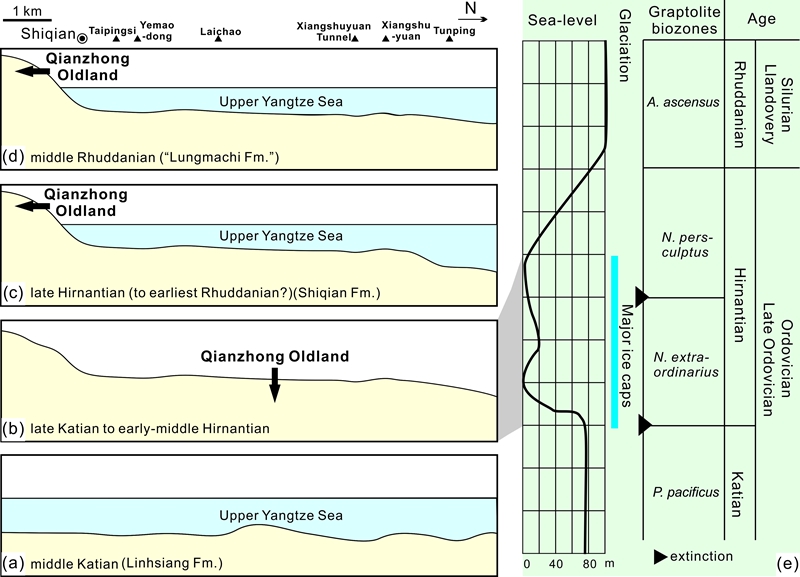South China is an internationally significant region for the study of a series of bio-events across the Ordovician and Silurian transition, where the Global Boundary Stratotype Section and Point (GSSP) for the base of the Hirnantian Series is located. However, the early-middle Hirnantian carbonate sediments, i.e. the Kuanyinchiao Formation, are commonly underlain and overlain by black graptolitic shales of the Wufeng Formation and the Lungmachi Formation respectively. The lack of a complete carbonate sequence across the Ordovician and Silurian (O-S) boundary may cause some problems in the correlation between the GSSP area and the shallow-water carbonate sequence in low latitudes, where graptolites are either absent or very rare.
Based on extensive investigation on more than 10 key O-S boundary sections in Shiqian County, northeastern Guizhou Province, Southwest China, Dr. WANG Guangxu from Nanjing Institute of Geology and Palaeontology, Chinese Academy of Sciences and his colleagues find that a stratigraphically more complete O-S boundary sequence is exposed at Tunping of the study area, where the sequence could be further subdivided into four lithological layers ascendingly, i.e. Interval 2, 3, 4a and 4b. Only the rocks of Interval 4b can be correlated with limestone (commonly about 1 m thick) at other localities. These carbonate rocks have distinct lithology and contain abundant shelly fossils, including tabulate and rugose corals, conodonts, brachiopods, trilobites and stromatoporoids, many of which show close Silurian affinities suggesting a much younger age than the Kuanyinchiao Formation. This observation, together with some addititional evidence of graptolites indicative of the Akidograptus ascensus biozone immediately overlying the Interval 4b at a nearby section, implies that these shelly strata are of latest Hirnantian age (possibly straddling the O-S boundary). Hence they were most likely deposited after the Hirnantian glaciation, rather than representing glacial cool water sediments (the Kuanyinchiao Formation) as previously thought. Owing to their unique lithology and palaeontology, these newly recognized carbonate rocks, here formally named as the Shiqian Formation, add substantially to our knowledge of O-S boundary stratigraphy in this region. O-S boundary sequence in Shiqian area typically reflect global glacio-eustatic sea-level changes.
The recognition of late Hirnantian carbonates together with shelly fossils completes the carbonate sequence of the O-S boundary in the Hirnantian GSSP area of South China. This necessitates the reconsideration of the patterns of faunal turnover of various shelly fossil groups in South China, and thus enhances correlation between the GSSP area and other carbonate-dominated regions lacking graptolites.
Related information of this paper: Wang Guangxu, Zhan Renbin, Percival Ian G., Huang Bing, Li Yue, Wu Rongchang. 2015. Late Hirnantian (latest Ordovician) carbonate rocks and shelly fossils in Shiqian, northeastern Guizhou, Southwest China. Newsletters on Stratigraphy, 48(3): 241-252. (DOI: 10.1127/nos/2015/0062)

Stratigraphic correlation of the Ordovician-Silurian boundary succession between Tunping (a) and other localities (b) in the Shiqian area, northeastern Guizhou. Note that numbers in parentheses indicate lithostratigraphic divisions used in this study.

Palaeogeographical change of the Shiqian area through the Ordovician-Silurian transition and its correlation with Hirnantian glaciation and associated sea-level change. (a). Pre-Hirnantian carbonate sedimentation; (b). Exposure spanning the late Katian to the middle Hirnantian interval; (c). Late Hirnantian carbonate sedimentation associated with sea-level rise; (d). Middle Rhuddanian siliciclastic sedimentation after possible hiatus; (e). Generalized diagram showing the Hirnantian glaciation and its associated sea-level change, modified from Brenchley et al. (2006).
